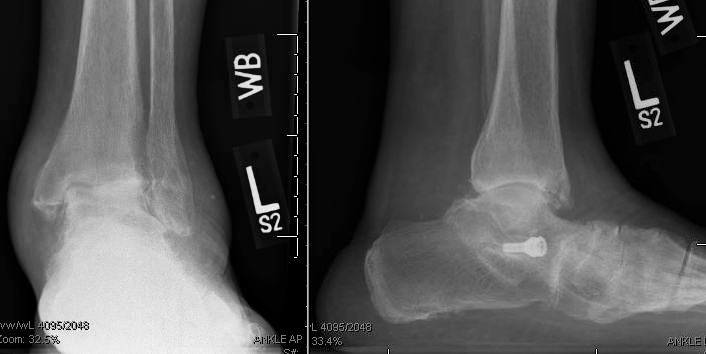Alternate Ankle Surgeries to relieve your Ankle Pain
Cartilage Repair: Microfracture Techniques
Injuries to the ankle’s articular cartilage have historically been treated using microfracture techniques. This process involves removing the damaged cartilage, as well as drilling into the underlying bone.
Microfracture involves drilling into the underlying bone or fenestration, which creates bleeding into the lesion as shown in the following arthroscopic photos. This intentional bleeding stimulates (marrow stimulation) facilitates fibrocartilage healing process of lesion.
The current findings are that the microfracture techniques heal injuries through its promotion of fibrocartilage regrowth. However, fibrocartilage is not as resistant to wear as native cartilage.
Therefore, while fibrocartilage has favorable short-term results, these benefits rarely last more than 5 years. So, it is likely that the procedure may fail leading to a recurrence of the ankle pain.
We recommend that microfracture techniques be utilized only in the case of cartilage injuries that are smaller than 10mm in size. For larger lesions and failed microfracture surgeries cartilage resurfacing techniques show promising results.
Treatment of complex bone and cartilage defects: Bone and cartilage grafting
The MRI photo below shows an ankle with damage to the joint cartilage and the formation of an underlying bone cyst (also called an osteochondral lesion).
Cartilage and Bone Repair: Grafting
The MRI photo below shows an ankle with damage to the joint cartilage and the formation of an underlying boneless cyst (also called an osteochondral lesion).
The formation of the cyst originates from damage to the overlying cartilage and the continuous erosion of the underlying bone. This damage is caused from the ankle joint’s fluid washing over the cartilage and hydraulically eroding the bone and creating a cyst.
These lesions generally do not heal without surgical procedures, and then also tend to enlarge with time.
Treating osteochondral lesions with underlying cysts and bone loss usually involves many aspects. The cyst is normally grafted with the person’s bone,and the implanted cadaver (or injectable synthetic bone graft).
The accompanying cartilage repair is often done using a cartilage graft. In the case of smaller lesions, the previously described microfracture techniques may also be used.
Bone Repair: Grafting
The following MRI image of an ankle illustrates an osteochondral lesion with an underlying cyst formation. Such conditions are resolved with bone grafting which is also called subchondroplasty procedure. This is typically a minimally invasive procedure where graft is injected into the lesion in a minimal invasive approach under x-ray guidance.
Grafting is shown to be effective in reducing ankle pain, promoting bone healing, and the resolution of the lesions. This procedure also creates a solid base for the restoration of your joint’s cartilage
Cartilage Repair Case: Grafting Treatment
Let’s consider a case of cartilage repair using the grafting procedure. The arthroscopic photos below show a cartilage defect in the ankle. This joint was also being grafted with living particulated juvenile cartilage (or cartilage allograft). This type of graft is living tissue that’s held together with biologic glue until the graft heals. This modern medical innovation of implanting living tissue has proven to be quite successful.
The resurfacing of the joint with cartilage gives the best results for healing and functional restoration of the ankle joint. But, if there’s an underlying cyst formation (or bone deficit), then that also should be grafted simultaneously with resurfacing cartilage. The detailed recommended treatment is determined by the MRI, the patient’s age, and the location of the osteochondral lesion.
Ankle Fusion
This ankle fusion procedure (also called ankle arthrodesis) fuses two ankle bones together.
This surgery is often recommended to correct extreme end-stage ankle arthritis in persons who don’t meet the requirements for ankle replacement surgery.
So, who normally gets an ankle fusion? This procedure is often reserved for younger patients with occupations that are physically demanding. The decision between ankle replacement versus ankle fusion is resolved by the evaluation and recommendations of the attending surgeon.
Ankle fusion can be done via the minimally invasive arthroscopic approach, which offers faster bone healing. But, an ankle fusion requires postoperative care. Patients have to use crutches (or other mobility aids) to keep the weight off the treated ankle until the fusion has healed. This recovery period varies between 6 to 16 weeks.
Ankle replacement with adjacent hindfoot fusions for degenerative ankle and flatfoot
The patient in this case suffered from chronic degenerative flatfoot, and degenerative ankle arthritis.
The earlier interventions included limited surgery. However, the patient continued to experience pain in the ankle and the adjacent hindfoot joints.
In this instance, the fusion of the adjacent joints (subtalar and talonavicular)was done as shown in the photos below.
The procedure was intended to treat painful arthritis in all three joints. The patient also had an ankle joint replacement done.
In cases like this where the joint replacement and fusion procedures are done the recovery is longer before weight bearing and rehabilitation can be started.


Get the Ankle Pain Relief That You Need!
While ankle replacement is a popular procedure, we have shared details about other alternate surgeries. The decision about which option to choose depends on your surgeon’s recommendations.
We invite you to set up your consultation with our expert surgeon Dr. Shannon Rush.
Contact us now to get on your journey to being free from ankle pain.








